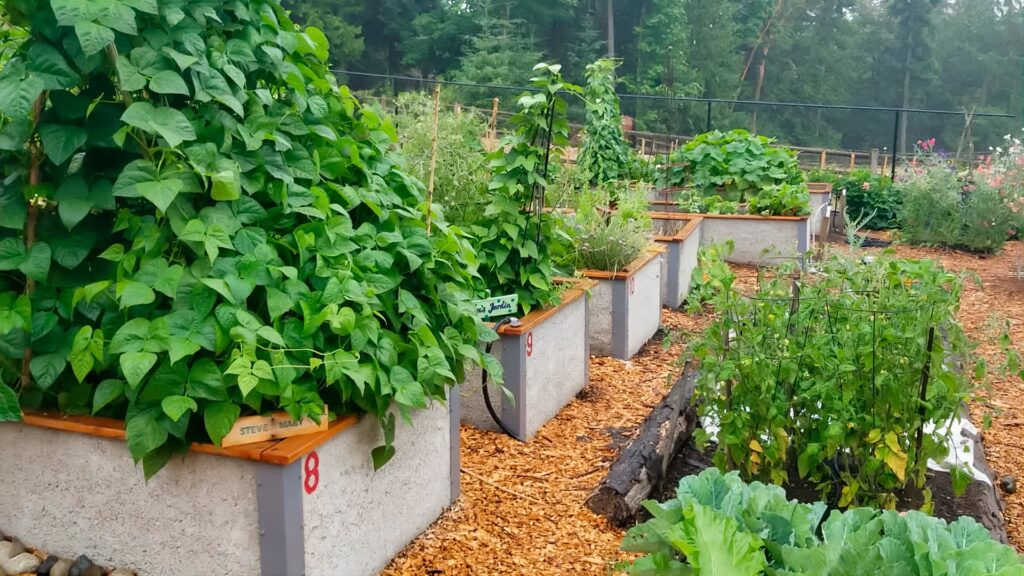Yes, you can put plants or seeds in the ground and enjoy at least some success with a garden. But you’ll reap the most rewards when you go into high yield vegetable gardening with a plan, from the ground up. The type of garden bed you use, the plants you buy, and the spacing of your plants all makes a difference. Here are our top tips for how to increase vegetable yield in your raised garden bed.
Astuce #1 Choisissez les bons matériaux pour votre lit de jardin surélevé
You’ll enjoy higher fruit and vegetable production with deeper garden beds. Not all plants have naturally deep roots, but those that do benefit from more root depth. Roots that are able to grow deeply anchor plants better. They grow more roots, which allows the plant to uptake nutrients more effectively. And, deeper roots help plants withstand drought better. Lits surélevés plus profonds permettent également un meilleur drainage.
Conseil #2 Choisissez des légumes à haut rendement
There are many high yield vegetables for small gardens. If you’re looking to get the most produce per square foot, choose veggies that are known to be prolific. Cherry and grape tomato varieties in particular, will result in the greatest quantity of tomatoes. You’ll also get more medium-sized tomatoes than you will get of the largest kinds. Vining cucumbers will produce in abundance, especially if you pick them regularly. Also, squash such as zucchini will keep coming if you keep picking. Bush beans are prolific producers. Believe it or not, planting okra can help you maximize your produce. Okra grows like crazy in the heat of the summer. Ask at your nursery for their recommendations for prolific producers and high yield vegetables for small gardens for your gardening zone.
Astuce #3 Concevoir un plan de jardin potager à haut rendement
Lits surélevés help maximize garden space because you don’t have to use space for walkways. Planting in squares or rows may look neat, but it uses space less effectively. Instead, arrange your plants in triangles. By doing so, you’ll be able to fit more plants into the same space. Don’t crowd them though! Another thing to consider is the sunlight. Plant tall plants where they won’t shade other plants. On the other hand, planting a tender crop like lettuce under the shade of a taller plant can keep your lettuce producing a little bit longer. As a general rule, tall crops should be planted on the north side of your garden and short crops on the southern side.
Conseil #4 Utilisez une bonne terre
If you can’t make your own rich compost and soil, look for the best soil to buy for vegetable gardening. Experts agree that rich soil that is deep, organically fed with nutrients, and crumbly in structure produces the healthiest roots. You can enrich soil with compost and organic matter such as composted leaves. Make or buy the highest quality compost you can. The richer the compost the more nutrients are available for your plants. Macronutrients your soil needs are the obvious — N, P, and K. Additionally, the best soil you can buy for a vegetable garden should also contain micronutrients and trace minerals such as sulfur, manganese, iron, copper, zinc, carbon, magnesium, calcium, boron, and iodine.
Astuce #5 Mettre en œuvre la plantation de succession
Créez une carte ou une chronologie de ce que vous retirerez et quand, et par quoi vous le remplacerez. La plantation de succession peut signifier plus d'une chose. Plantez plus d'une culture de choses qui poussent rapidement, comme des radis. Une autre façon de mettre en œuvre la plantation de succession consiste à choisir différentes variétés d'une même culture qui ont des dates de maturité différentes - des tomates ultra précoces suivies de tomates tardives, par exemple. Dans le même espace, vous pourriez planter de la laitue au printemps, une tomate à maturation précoce, suivie de chou pour une culture d'hiver. Intercalez des graines de radis avec des graines de carotte. Les radis sont généralement disponibles pour la récolte après environ cinq semaines, et les carottes en prennent environ sept. Ces types de stratégies sont des choses faciles à faire pour un plan de potager à haut rendement.
Conclusion
No one starts a garden and says, “I hope to get just two of these green peppers, and a handful of tomatoes will be fine.” No! If you’re going to install des lits surélevés qui dureront des années and put the effort into your garden, you want to get the maximum amount of produce possible. Gardening can sometimes be tricky, that’s for sure. But some basic strategies around what plants you buy and where you put them are sure-fire ways for how to increase vegetable yield.
